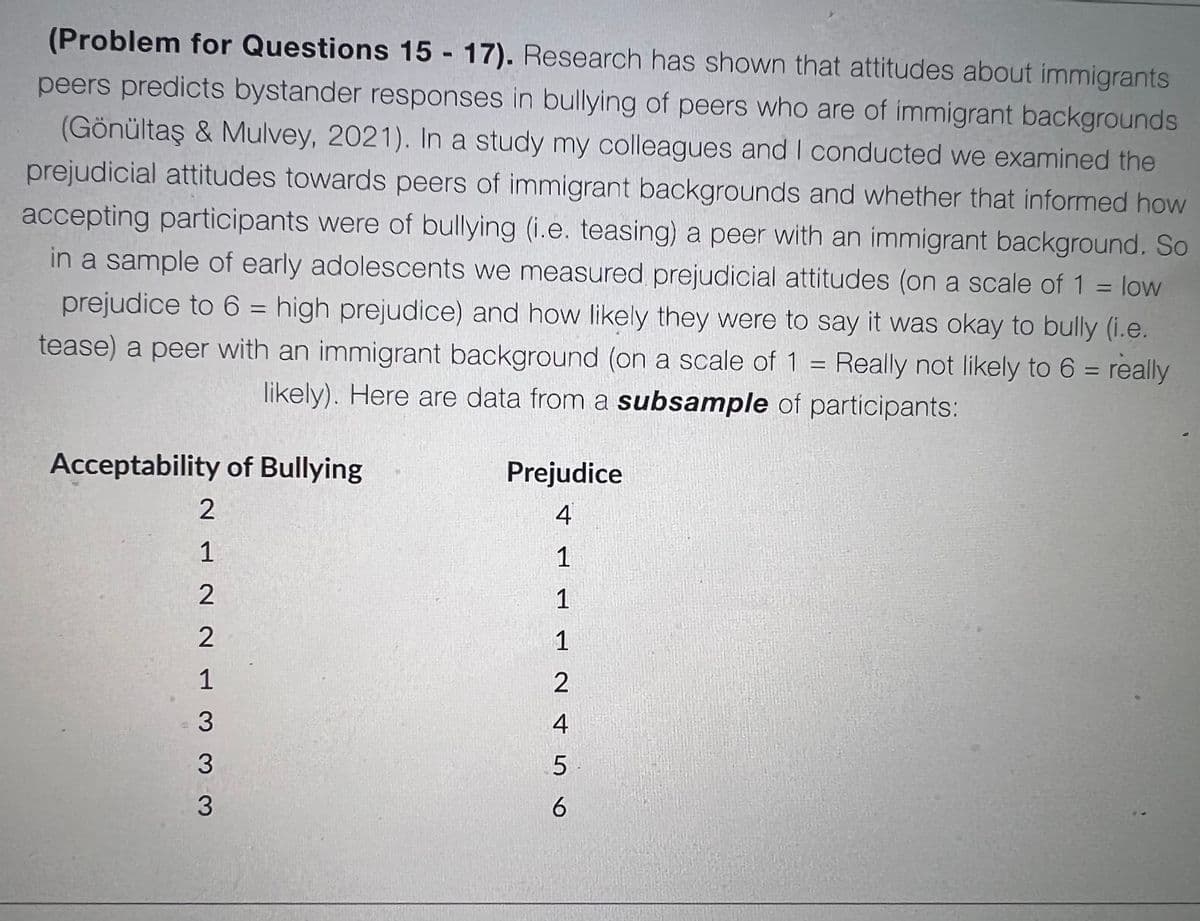(Problem for Questions 15 17). Research has shown that attitudes about immigrants peers predicts bystander responses in bullying of peers who are of immigrant backgrounds (Gönültaş & Mulvey, 2021). In a study my colleagues and I conducted we examined the prejudicial attitudes towards peers of immigrant backgrounds and whether that informed how accepting participants were of bullying (i.e. teasing) a peer with an immigrant background. So in a sample of early adolescents we measured prejudicial attitudes (on a scale of 1 = low prejudice to 6 = high prejudice) and how likely they were to say it was okay to bully (i.e. tease) a peer with an immigrant background (on a scale of 1 = Really not likely to 6 = really likely). Here are data from a subsample of participants: Acceptability of Bullying Prejudice 4 1 1 2 1 1 1 4 3. 6.
(Problem for Questions 15 17). Research has shown that attitudes about immigrants peers predicts bystander responses in bullying of peers who are of immigrant backgrounds (Gönültaş & Mulvey, 2021). In a study my colleagues and I conducted we examined the prejudicial attitudes towards peers of immigrant backgrounds and whether that informed how accepting participants were of bullying (i.e. teasing) a peer with an immigrant background. So in a sample of early adolescents we measured prejudicial attitudes (on a scale of 1 = low prejudice to 6 = high prejudice) and how likely they were to say it was okay to bully (i.e. tease) a peer with an immigrant background (on a scale of 1 = Really not likely to 6 = really likely). Here are data from a subsample of participants: Acceptability of Bullying Prejudice 4 1 1 2 1 1 1 4 3. 6.
Glencoe Algebra 1, Student Edition, 9780079039897, 0079039898, 2018
18th Edition
ISBN:9780079039897
Author:Carter
Publisher:Carter
Chapter10: Statistics
Section10.6: Summarizing Categorical Data
Problem 27PPS
Related questions
Question
15) Fine the sum of products (SP) and sum of squares (SS) for the variables of interest mentioned in the study above. Then find the
a) SP =
b) SSbullying =
c) SSprejudice =
d) r =

Transcribed Image Text:(Problem for Questions 15 17). Research has shown that attitudes about immigrants
peers predicts bystander responses in bullying of peers who are of immigrant backgrounds
(Gönültaş & Mulvey, 2021). In a study my colleagues and | conducted we examined the
prejudicial attitudes towards peers of immigrant backgrounds and whether that informed how
accepting participants were of bullying (i.e. teasing) a peer with an immigrant background. So
in a sample of early adolescents we measured prejudicial attitudes (on a scale of 1 = low
prejudice to 6 = high prejudice) and how likely they were to say it was okay to bully (i.e.
tease) a peer with an immigrant background (on a scale of 1 = Really not likely to 6 = really
likely). Here are data from a subsample of participants:
Acceptability of Bullying
Prejudice
2
4
1
1
2
1
1
1
2
4
Expert Solution
This question has been solved!
Explore an expertly crafted, step-by-step solution for a thorough understanding of key concepts.
This is a popular solution!
Trending now
This is a popular solution!
Step by step
Solved in 2 steps with 2 images

Recommended textbooks for you

Glencoe Algebra 1, Student Edition, 9780079039897…
Algebra
ISBN:
9780079039897
Author:
Carter
Publisher:
McGraw Hill

Big Ideas Math A Bridge To Success Algebra 1: Stu…
Algebra
ISBN:
9781680331141
Author:
HOUGHTON MIFFLIN HARCOURT
Publisher:
Houghton Mifflin Harcourt

Glencoe Algebra 1, Student Edition, 9780079039897…
Algebra
ISBN:
9780079039897
Author:
Carter
Publisher:
McGraw Hill

Big Ideas Math A Bridge To Success Algebra 1: Stu…
Algebra
ISBN:
9781680331141
Author:
HOUGHTON MIFFLIN HARCOURT
Publisher:
Houghton Mifflin Harcourt